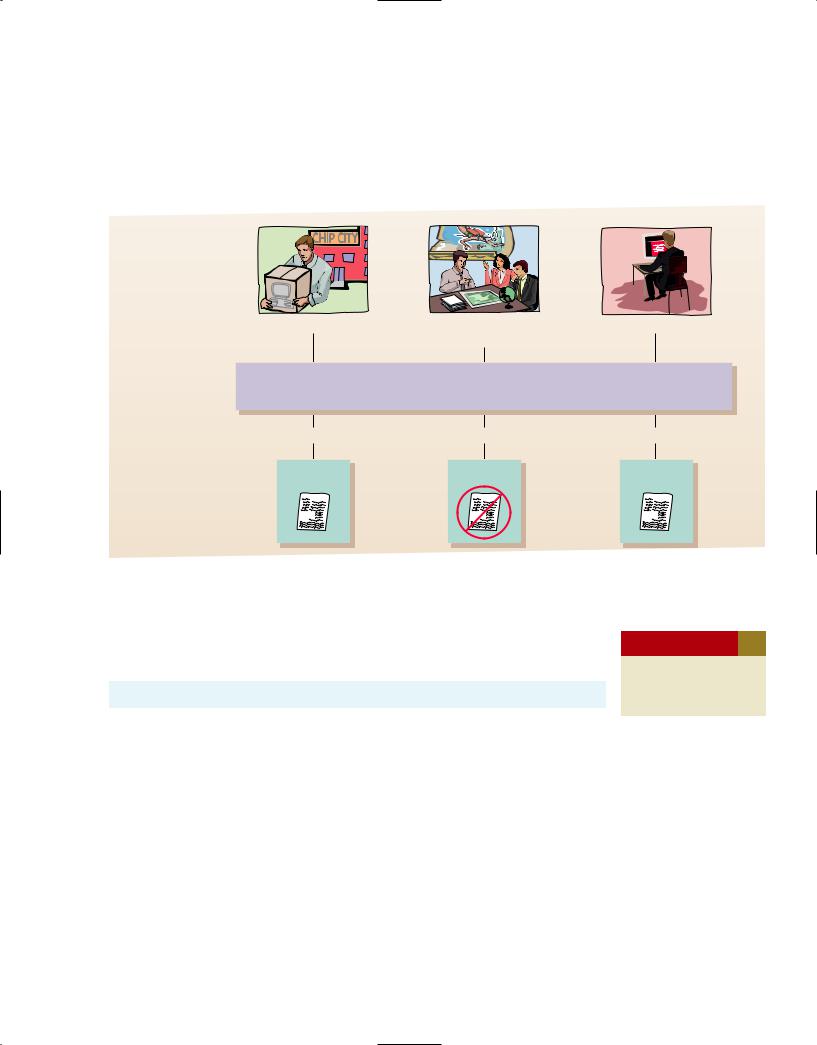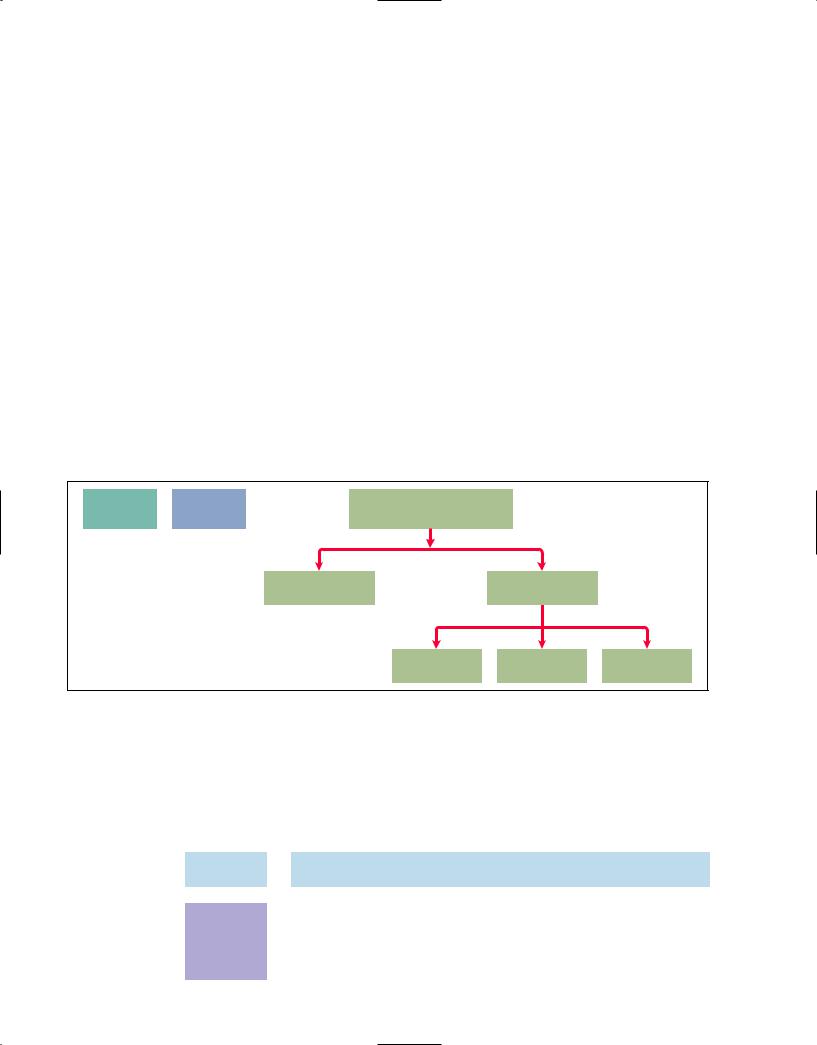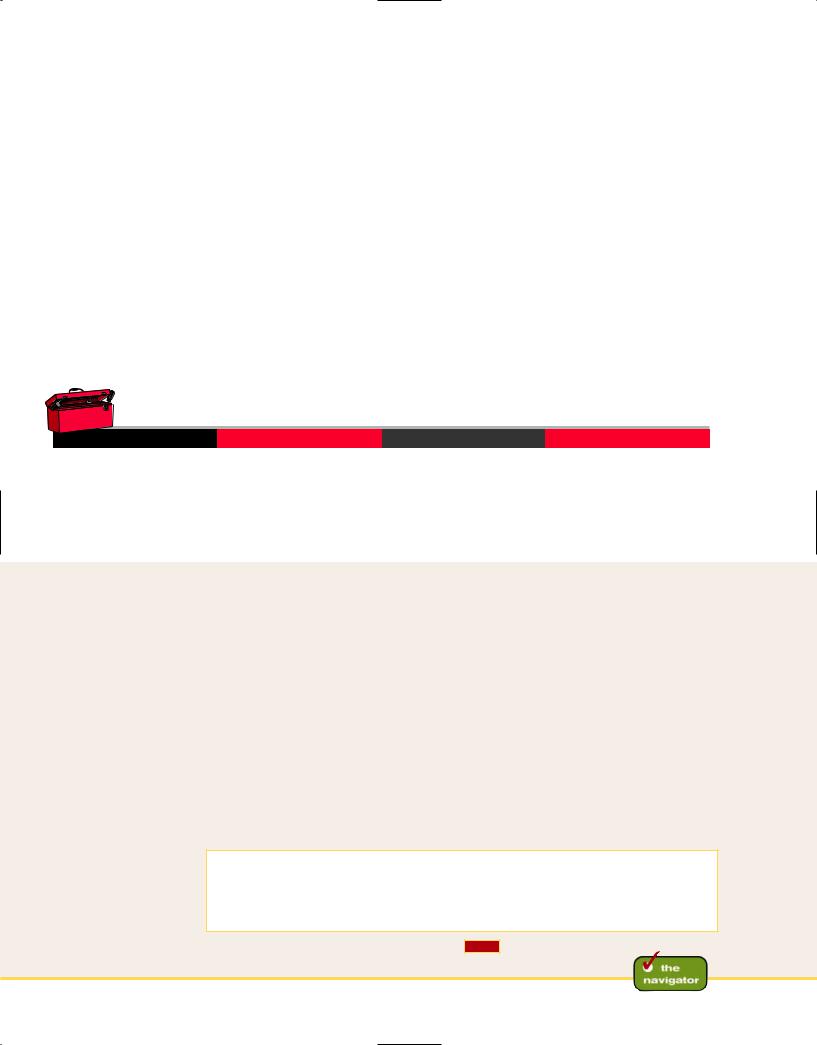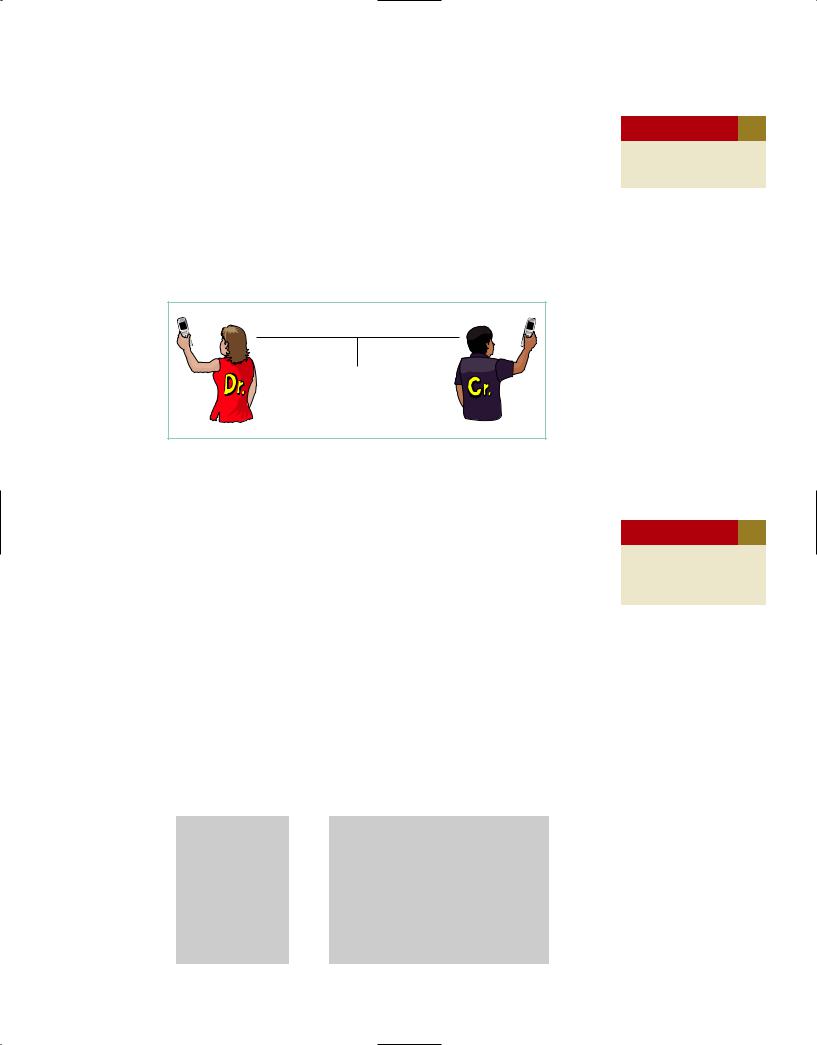
Финансовый учет. Ридер
.pdf
230
preview of chapter 3
As indicated in the Feature Story, a reliable information system is a necessity for any company. The purpose of this chapter is to explain and illustrate the features of an accounting information system. The organization and content of the chapter are as follows.
The Accounting Information System
|
Accounting |
|
|
The Account |
|
|
Steps in the |
|
The Recording |
|
Transactions |
|
|
|
|
Recording Process |
|
Process Illustrated |
|
|
|
|
|
|
|
|
|||
|
|
|
|
|
|
|
|
|
|
• |
Analyzing |
|
• |
Debits and credits |
|
• |
The journal |
|
• Summary illustration |
|
transactions |
|
• |
Debit and credit |
|
• |
The ledger |
|
of journalizing and |
|
|
|
|
|
posting |
||||
• |
Summary of |
|
|
procedures |
|
• |
Chart of accounts |
|
|
|
|
|
|
|
|||||
|
transactions |
|
• |
Stockholders’ equity |
|
|
|
||
|
|
|
• |
Posting |
|
|
|||
|
|
|
|
|
|
||||
|
|
|
|
relationships |
|
|
|
||
|
|
|
|
|
|
|
|
|
|
|
|
|
• |
Summary of |
|
|
|
|
|
|
|
|
|
debit/credit rules |
|
|
|
|
|
|
|
|
|
|
|
|
|
|
|
The Trial Balance
•Limitations of a trial balance
The Accounting Information System
The system of collecting and processing transaction data and communicating financial information to decision makers is known as the accounting information system. Factors that shape these systems include: the nature of the company’s business, the types of transactions, the size of the company, the volume of data, and the information demands of management and others.
Most businesses use computerized accounting systems—sometimes referred to as electronic data processing (EDP) systems. These systems handle all the steps involved in the recording process, from initial data entry to preparation of the financial statements. In order to remain competitive, companies continually improve their accounting systems to provide accurate and timely data for decision making. For example, in a recent annual report, Tootsie Roll states, “We also invested in additional processing and data storage hardware during the year. We view information technology as a key strategic tool, and are committed to deploying leading edge technology in this area.” In addition, many companies have upgraded their accounting information systems in response to the requirements of Sarbanes-Oxley.
In this chapter, we focus on a manual accounting system because the accounting concepts and principles do not change whether a system is computerized or manual, and manual systems are easier to illustrate.
Accounting Transactions
To use an accounting information system, you need to know which economic events to recognize (record). Not all events are recorded and reported in the financial statements. For example, suppose General Motors hired a new employee or purchased a new computer. Are these events entered in its accounting records? The first event would not be recorded, but the second event would. We call economic events that require recording in the financial statements accounting transactions.
An accounting transaction occurs when assets, liabilities, or stockholders’ equity items change as a result of some economic event. The purchase of a
102

231
Accounting Transactions 103
computer by General Motors, the payment of rent by Microsoft, and the sale of a multi-day guided trip by Sierra Corporation are examples of events that change a company’s assets, liabilities, or stockholders’ equity. Illustration 3-1 summarizes the decision process companies use to decide whether or not to record economic events.
Illustration 3-1
Transaction identification process
|
|
|
Bank |
Events |
|
|
|
|
DELL |
|
|
|
Purchase computer |
Discuss guided trip options |
Pay rent |
|
|
with potential customer |
|
Criterion |
Is the financial position (assets, liabilities, or stockholders’ equity) of the company changed? |
||
Yes |
No |
|
Record |
Don't |
|
record |
||
|
Record/
Don’t Record
ANALYZING TRANSACTIONS
In Chapter 1, you learned the basic accounting equation:
Assets Liabilities Stockholders’ Equity
Yes
Record
study objective 1
Analyze the effect of business transactions on the basic accounting equation.
In this chapter, you will learn how to analyze transactions in terms of their effect on assets, liabilities, and stockholders’ equity. Transaction analysis is the process of identifying the specific effects of economic events on the accounting equation.
The accounting equation must always balance. Each transaction has a dual (double-sided) effect on the equation. For example, if an individual asset is increased, there must be a corresponding:
Decrease in another asset, or
Increase in a specific liability, or
Increase in stockholders’ equity.
Two or more items could be affected when an asset is increased. For example, if a company purchases a computer for $10,000 by paying $6,000 in cash and signing a note for $4,000, one asset (equipment) increases $10,000, another asset (cash) decreases $6,000, and a liability (notes payable) increases $4,000.

232
104 chapter 3 The Accounting Information System
The result is that the accounting equation remains in balance—assets increased by a net $4,000 and liabilities increased by $4,000, as shown below.
|
Assets |
|
Liabilities Stockholders’ Equity |
||||
|
|
|
|
|
|
|
|
$10,000 |
|
$4,000 |
|
|
|
||
|
6,000 |
|
|
|
|
|
|
$ |
4,000 |
|
$4,000 |
|
|
|
|
|
|
|
|
|
|
|
|
Chapter 1 presented the financial statements for Sierra Corporation for its first month. You should review those financial statements (on page 17) at this time. To illustrate how economic events affect the accounting equation, we will examine events affecting Sierra Corporation during its first month.
In order to analyze the transactions for Sierra Corporation, we will expand the basic accounting equation. This will allow us to better illustrate the impact of transactions on stockholders’ equity. Recall from the balance sheets in Chapters 1 and 2 that stockholders’ equity is comprised of two parts: common stock and retained earnings. Common stock is affected when the company issues new shares of stock in exchange for cash. Retained earnings is affected when the company earns revenue, incurs expenses, or pays dividends. Illustration 3-2 shows the expanded equation.
Illustration 3-2 Expanded accounting equation
Assets
Liabilities
Stockholders' Equity
Common Stock
|
Retained Earnings |
Revenues |
|
Expenses |
|
Dividends |
If you are tempted to skip ahead after you’ve read a few of the following transaction analyses, don’t do it. Each has something unique to teach, something you’ll need later. (We assure you that we’ve kept them to the minimum needed!)
EVENT (1). INVESTMENT OF CASH BY STOCKHOLDERS. On October 1, cash of $10,000 is invested in the business by investors (primarily your friends and family) in exchange for $10,000 of common stock. This event is an accounting transaction because it results in an increase in both assets and stockholders’ equity.
Basic
Analysis
Equation
Analysis
The asset Cash is increased $10,000, and stockholders’ equity (specifically Common Stock) is increased $10,000.
|
|
|
Assets |
Liabilities |
|
|
Stockholders’ Equity |
||||
|
|
|
|
|
|
|
|
Common |
|
|
|
|
|
|
Cash |
|
|
|
|
Stock |
|
|
|
|
(1) |
$10,000 |
|
|
$10,000 |
Issued stock |
|
||||
|
|
|
|
|
|
|
|
|
|
|
|

233
Accounting Transactions 105
The equation is in balance after the issuance of common stock. Keeping track of the source of each change in stockholders’ equity is essential for later accounting activities. In particular, items recorded in the revenue and expense columns are used for the calculation of net income.
EVENT (2). NOTE ISSUED IN EXCHANGE FOR CASH. On October 1, Sierra borrowed $5,000 from Castle Bank by signing a 3-month, 12%, $5,000 note payable. This transaction results in an equal increase in assets and liabilities. The specific effect of this transaction and the cumulative effect of the first two transactions are:
Basic
Analysis
Equation
Analysis
The asset Cash is increased $5,000, and the liability Notes Payable is increased $5,000.
Assets |
|
Liabilities |
|
Stockholders’ Equity |
||||
|
|
|
Notes |
|
|
Common |
||
Cash |
|
|
Payable |
|
|
|
Stock |
|
$10,000 |
|
|
|
|
|
$10,000 |
|
|
(2)5,000 $5,000
$15,000 $5,000 |
$10,000 |
⎪ ⎪ ⎪ ⎪ ⎪ ⎪ ⎪ ⎪ ⎪ ⎨ ⎪ ⎪ ⎪ ⎪ ⎪ ⎪ ⎪ ⎪ ⎪ ⎩ |
|
$15,000 |
|
Total assets are now $15,000, and liabilities plus stockholders’ equity also total $15,000.
EVENT (3). PURCHASE OF OFFICE EQUIPMENT FOR CASH. On October 2, Sierra purchased equipment by paying $5,000 cash to Superior Equipment Sales Co. This event is a transaction because an equal increase and decrease in Sierra’s assets occur.
Basic
Analysis
Equation
Analysis
The asset Equipment is increased $5,000; the asset Cash is decreased $5,000.
|
|
|
Assets |
|
Liabilities |
|
Stockholders’ Equity |
|
|||||||||
|
|
|
|
|
|
|
|
|
Notes |
|
|
Common |
|||||
|
|
Cash |
|
|
Equipment |
|
|
Payable |
|
|
|
|
Stock |
|
|||
$15,000 |
|
|
|
|
|
$5,000 |
|
|
$10,000 |
|
|
||||||
|
(3) 5,000 |
|
|
$5,000 |
|
|
|
|
|
|
|
|
|
|
|
||
|
|
|
|
|
|
|
|
|
|
|
|
|
|
|
|
|
|
|
$10,000 |
|
|
$5,000 |
|
$5,000 |
|
|
$10,000 |
|
|
||||||
|
⎪ ⎪ ⎪ ⎪ ⎪ ⎪ ⎪ ⎨ ⎪ ⎪ ⎪ ⎪ ⎪ ⎪ ⎪ ⎩ |
|
⎪ ⎪ ⎪ ⎪ ⎪ ⎪ ⎪ ⎪ ⎪ ⎨ ⎪ ⎪ ⎪ ⎪ ⎪ ⎪ ⎪ ⎪ ⎪ ⎩ |
||||||||||||||
|
|
|
$15,000 |
|
|
|
|
|
|
$15,000 |
|
|
|
|
|
||
The total assets are now $15,000, and liabilities plus stockholders’ equity also total $15,000.
EVENT (4). RECEIPT OF CASH IN ADVANCE FROM CUSTOMER. On October 2, Sierra received a $1,200 cash advance from R. Knox, a client. This event is a transaction because Sierra received cash (an asset) for guide services for multi-day trips that are expected to be completed by Sierra in the future. Although Sierra received cash, it does not record revenue until it has performed the work. In some industries, such as the magazine and airline industries, customers are expected to prepay. These companies have a liability to the customer until they deliver the magazines or provide the flight. When the company eventually provides the product or service, it records the revenue.

106 chapter 3 |
|
|
|
|
|
|
|
|
|
|
|
|
234 |
|
|
|
|
|
|
|
|||
|
The Accounting Information System |
|
|
|
|
|
|
||||||||||||||||
|
|
|
|
|
|
Since Sierra received cash prior to performance of the service, Sierra has a |
|||||||||||||||||
|
|
|
|
|
liability for the work due. |
|
|
|
|
|
|
|
|
|
|||||||||
|
|
|
|
|
|
|
|
|
|
|
|
|
|
|
|
|
|||||||
Basic |
|
|
The asset Cash is increased $1,200; the liability Unearned Service Revenue is increased $1,200 because |
||||||||||||||||||||
|
|
the service has not been provided yet. That is, when an advance payment is received, an unearned revenue |
|||||||||||||||||||||
Analysis |
|
|
|||||||||||||||||||||
|
|
(a liability) should be recorded in order to recognize the obligation that exists. |
|||||||||||||||||||||
|
|
|
|
||||||||||||||||||||
|
|
|
|
|
|
|
|
|
|
|
|
|
|
|
|
|
|
|
|
|
|
|
|
|
|
|
|
|
|
|
|
|
|
|
|
|
|
|
|
|
|
|
|
|
|
|
|
Equation |
|
|
|
|
|
|
|
|
|
|
|
|
|
|
|
|
|
|
|
|
|
|
|
Analysis |
|
|
|
|
|
|
|
|
|
|
|
|
|
|
|
|
|
|
|
|
|
|
|
|
|
|
|
Assets |
|
|
|
|
|
|
|
|
Liabilities |
|
Stockholders’ Equity |
|
|||||||
|
|
|
|
|
|
|
|
|
|
|
|||||||||||||
|
|
|
|
|
|
|
|
Equip- |
|
|
Notes |
|
Unearned Service |
|
|
Common |
|||||||
|
|
|
|
Cash |
|
|
|
ment |
|
|
|
Payable |
|
|
Revenue |
|
|
Stock |
|
||||
|
|
|
$10,000 |
|
$5,000 |
|
|
$5,000 |
|
|
|
|
|
|
$10,000 |
|
|
|
|||||
|
(4) |
|
|
1,200 |
|
|
|
|
|
|
|
|
|
|
|
$1,200 |
|
|
|
|
|
|
|
|
|
|
$11,200 |
|
|
$5,000 |
|
|
$5,000 |
|
|
|
$1,200 |
|
|
$10,000 |
|
|
|
||||
|
|
|
⎪ ⎪ ⎪ ⎪ ⎪ ⎪ ⎪ ⎨ ⎪ ⎪ ⎪ ⎪ ⎪ ⎪ ⎩ |
|
⎪ ⎪ ⎪ ⎪ ⎪ ⎪ ⎪ ⎪ ⎪ ⎪ ⎪ ⎪ ⎪ ⎪ ⎪ ⎪ ⎪ ⎨ ⎪ ⎪ ⎪ ⎪ ⎪ ⎪ ⎪ ⎪ ⎪ ⎪ ⎪ ⎪ ⎪ ⎪ ⎪ ⎪ ⎩ |
||||||||||||||||||
|
|
|
|
|
$16,200 |
|
|
|
|
|
|
$16,200 |
|
|
|
|
|
|
|||||
Basic
Analysis
EVENT (5). SERVICES PROVIDED FOR CASH. On October 3, Sierra received $10,000 in cash from Copa Company for guide services performed for a corporate event. This event is a transaction because Sierra received an asset (cash) in exchange for services.
Guide service is the principal revenue-producing activity of Sierra. Revenue increases stockholders’ equity. This transaction, then, increases both assets and stockholders’ equity.
The asset Cash is increased $10,000; the revenue Service Revenue is increased $10,000.
Equation
Analysis
|
Assets |
|
|
|
|
|
Liabilities |
|
|
|
|
Stockholders’ Equity |
|
|
|
|
||||||||||||
|
|
|
|
Equip- |
|
|
|
Notes |
|
Unearned |
|
Common |
|
|
Retained Earnings |
|
|
|
|
|||||||||
|
Cash |
|
ment |
|
|
|
|
Pay. |
|
Serv. Rev. |
|
|
Stock |
|
|
Rev. Exp. |
Div. |
|||||||||||
$11,200 |
|
$5,000 |
|
|
|
$5,000 |
|
|
$1,200 |
|
|
$10,000 |
|
|
|
|
|
|
|
|
|
|
|
|||||
(5) 10,000 |
|
|
|
|
|
|
|
|
|
|
|
|
|
|
|
|
|
$10,000 |
|
Service |
||||||||
|
|
|
|
|
|
|
|
|
|
|
|
|
|
|
|
|
|
|
|
|
|
|
|
|
|
Revenue |
||
|
$21,200 |
|
$5,000 |
|
|
$5,000 |
|
|
$1,200 |
|
|
$10,000 |
|
|
$10,000 |
|
|
|
||||||||||
|
|
|
|
|
|
|
|
|
|
|
||||||||||||||||||
|
|
|
|
|
|
|
|
|
|
|
||||||||||||||||||
⎪ ⎪ ⎪ ⎪ ⎪ ⎨ ⎪ ⎪ ⎪ ⎪ ⎪ ⎩ |
|
⎪ ⎪ ⎪ ⎪ ⎪ ⎪ ⎪ ⎪ ⎪ ⎪ ⎪ ⎪ ⎪ ⎪ ⎪ ⎪ ⎪ ⎨ ⎪ ⎪ ⎪ ⎪ ⎪ ⎪ ⎪ ⎪ ⎪ ⎪ ⎪ ⎪ ⎪ ⎪ ⎪ ⎩ |
|
|
|
|
||||||||||||||||||||||
$26,200 |
|
|
|
|
|
|
|
|
|
|
|
$26,200 |
|
|
|
|
|
|
|
|
|
|
|
|||||
Often companies provide services “on account.” That is, they provide service for which they are paid at a later date. Revenue, however, is earned when services are performed. Therefore, revenues would increase when services are performed, even though cash has not been received. Instead of receiving cash, the company receives a different type of asset, an account receivable. Accounts receivable represent the right to receive payment at a later date. Suppose that Sierra had provided these services on account rather than for cash. This event would be reported using the accounting equation as:
|
Assets |
|
Liabilities |
Stockholders’ Equity |
|||||
|
Accounts |
|
|
|
|
|
|
|
|
|
Receivable |
|
|
|
|
Revenues |
|||
|
|
|
|
|
|
|
|
|
|
|
$10,000 |
|
|
|
$10,000 Service Revenue |
||||
|
|
|
|
|
|
|
|
|
|
Later, when Sierra collects the $10,000 from the customer, Accounts Receivable declines by $10,000, and Cash increases by $10,000.


236
108 chapter 3 The Accounting Information System
EVENT (8). PURCHASE OF SUPPLIES ON ACCOUNT. On October 5, Sierra purchased supplies on account from Aero Supply for $2,500. In this case, “on account” means that the company receives goods or services that it will pay for at a later date.
Basic
The asset Supplies is increased $2,500; the liability Accounts Payable is increased $2,500.
Analysis
Equation
Analysis
|
|
|
Assets |
|
|
|
|
|
|
|
|
|
|
|
|
|
Liabilities |
|
|
|
|
|
|
|
|
Stockholders’ Equity |
||||||||
|
|
|
|
|
Prepd. |
|
Equip- |
|
Notes |
|
|
Accounts |
|
Unearned |
|
Common |
|
|
Retained Earnings |
|||||||||||||||
|
Cash |
|
Supplies |
|
Insur. |
|
ment |
|
|
Pay. |
|
|
Payable |
|
|
Serv. Rev. |
|
|
Stock |
|
|
Rev. |
|
Exp. Div. |
||||||||||
|
$19,700 |
|
|
|
$600 |
|
|
$5,000 |
|
|
|
|
$5,000 |
|
|
|
|
|
|
$1,200 |
|
|
$10,000 |
|
|
$10,000 |
|
$900 |
|
|
||||
(8) |
|
|
$2,500 |
|
|
|
|
|
|
|
|
|
|
|
|
|
|
$2,500 |
|
|
|
|
|
|
|
|
|
|
|
|
|
|
|
|
|
|
|
|
|
|
|
|
|
|
|
|
|
|
|
|
|
|
|
|
|
|
|
|
|
|
|
|
|
|
|
|
|
|
|
$19,700 |
|
$2,500 |
|
$600 |
|
|
$5,000 |
|
|
|
|
$5,000 |
|
|
$2,500 |
|
|
$1,200 |
|
|
$10,000 |
|
|
$10,000 |
|
$900 |
|
|
||||||
⎪ ⎪ ⎪ ⎪ ⎪ ⎪ ⎪ ⎪ ⎪ ⎪ ⎪ ⎨ ⎪ ⎪ ⎪ ⎪ ⎪ ⎪ ⎪ ⎪ ⎪ ⎪ ⎪ ⎩ |
|
⎪ ⎪ ⎪ ⎪ ⎪ ⎪ ⎪ ⎪ ⎪ ⎪ ⎪ ⎪ ⎪ ⎨ ⎪ ⎪ ⎪ ⎪ ⎪ ⎪ ⎪ ⎪ ⎪ ⎪ ⎪ ⎪ ⎩ |
||||||||||||||||||||||||||||||||
|
|
|
$27,800 |
|
|
|
|
|
|
|
|
|
|
|
|
|
|
|
|
$27,800 |
|
|
|
|
|
|
|
|
|
|
||||
EVENT (9). HIRING OF NEW EMPLOYEES. On October 9, Sierra hired four new employees to begin work on October 15. Each employee will receive a weekly salary of $500 for a five-day work week, payable every two weeks. Employees will receive their first paychecks on October 26. On the date Sierra hires the employees, there is no effect on the accounting equation because the assets, liabilities, and stockholders’ equity of the company have not changed.
Basic |
|
An accounting transaction has not occurred. There is only an agreement that the employees will begin |
Analysis |
|
work on October 15. (See Event (11) for the first payment.) |
|
|
|
EVENT (10). PAYMENT OF DIVIDEND. On October 20, Sierra paid a $500 dividend. Dividends are a reduction of stockholders’ equity but not an expense. Dividends are not included in the calculation of net income. Instead, a dividend is a distribution of the company’s assets to its stockholders.
Basic
The dividends account is increased $500; the asset Cash is decreased $500.
Analysis
Equation
Analysis
|
|
|
Assets |
|
|
|
|
|
Liabilities |
|
|
Stockholders’ Equity |
|
|
|
||||||||||||||||
|
|
|
Sup- |
|
Prepd. |
|
Equip- |
|
Notes |
|
Accts. |
|
Unearned |
|
Common |
|
Retained Earnings |
|
|||||||||||||
|
Cash |
plies |
Insur. |
ment |
Pay. |
|
Pay. |
Serv. Rev. |
|
|
Stock |
|
Rev. |
Exp. |
Div. |
|
|||||||||||||||
|
$19,700 |
|
$2,500 |
|
$600 |
|
|
$5,000 |
|
|
$5,000 |
|
|
$2,500 |
|
$1,200 |
|
|
$10,000 |
|
|
$10,000 |
|
$900 |
|
|
|
|
|||
(10) 500 |
|
|
|
|
|
|
|
|
|
|
|
|
|
|
|
|
|
|
|
|
|
|
|
|
|
|
|
$500 |
|
||
|
|
|
|
|
|
|
|
|
|
|
|
|
|
|
|
|
|
|
|
|
|
|
|
|
|
|
|
|
|
|
|
$19,200 |
$2,500 |
$600 |
|
$5,000 |
|
$5,000 $2,500 |
$1,200 |
|
$10,000 |
|
$10,000 |
$900 |
|
$500 |
|
||||||||||||||||
⎪ ⎪ ⎪ ⎪ ⎪ ⎪ ⎪ ⎪ ⎪ ⎪ ⎨ ⎪ ⎪ ⎪ ⎪ ⎪ ⎪ ⎪ ⎪ ⎪ ⎪ ⎪ ⎩ |
⎪ ⎪ ⎪ ⎪ ⎪ ⎪ ⎪ ⎪ ⎪ ⎪ ⎪ ⎪ ⎪ ⎪ ⎪ ⎪ ⎪ ⎪ ⎪ ⎪ ⎪ ⎪ ⎨ ⎪ ⎪ ⎪ ⎪ ⎪ ⎪ ⎪ ⎪ ⎪ ⎪ ⎪ ⎪ ⎪ ⎪ ⎪ ⎪ ⎪ ⎪ ⎪ ⎪ ⎪ ⎪ ⎪ ⎩ |
|
|||||||||||||||||||||||||||||
|
|
$27,300 |
|
|
|
|
|
|
|
|
|
|
|
|
|
|
$27,300 |
|
|
|
|
|
|
|
|
|
|||||
EVENT (11). PAYMENT OF CASH FOR EMPLOYEE SALARIES. Employees have worked two weeks, earning $4,000 in salaries, which were paid on October 26.

237
Accounting Transactions 109
Salaries Expense is an expense that reduces stockholders’ equity. This event is a transaction because assets and stockholders’ equity are affected.
Basic
The asset Cash is decreased $4,000; the expense account Salaries Expense is increased $4,000.
Analysis
Equation
Analysis
|
|
|
|
Assets |
|
|
|
Liabilities |
|
|
|
|
|
|
|
|
Stockholders’ Equity |
|
|
|
|
|
||||||||||||||
|
|
|
|
Sup- |
|
Prepd. |
|
Equip- |
|
Notes |
|
Accts. |
|
Unearned |
|
|
Common |
|
Retained Earnings |
|
|
|
|
|
||||||||||||
|
Cash |
plies |
Insur. |
ment |
Pay. |
Pay. |
Serv. Rev. |
|
|
|
Stock |
Rev. |
|
|
Exp. |
|
|
Div. |
|
|||||||||||||||||
|
|
|
|
|
|
|
|
|
|
|
|
|
|
|
|
|
|
|
|
|
|
|
|
|
|
|
|
|
|
|
|
|
|
|
|
|
$19,200 |
$2,500 |
$600 |
$5,000 |
$5,000 |
$2,500 |
|
$1,200 |
|
|
$10,000 |
$10,000 |
|
$ 900 |
|
$500 |
|
||||||||||||||||||||
(11) 4,000 |
|
|
|
|
|
|
|
|
|
|
|
|
|
|
|
|
|
|
|
|
|
|
|
|
|
4,000 |
|
|
|
|
|
Salaries |
||||
|
|
|
|
|
|
|
|
|
|
|
|
|
|
|
|
|
|
|
|
|
|
|
|
|
|
|
|
|
|
|
|
|
|
|
Expense |
|
$15,200 |
$2,500 |
$600 |
$5,000 |
$5,000 |
$2,500 |
|
$1,200 |
|
$10,000 |
$10,000 |
$4,900 |
|
$500 |
|||||||||||||||||||||||
|
||||||||||||||||||||||||||||||||||||
⎪ ⎪ ⎪ ⎪ ⎪ ⎪ ⎪ ⎪ ⎪ ⎨ ⎪ ⎪ ⎪ ⎪ ⎪ ⎪ ⎪ ⎪ ⎪ ⎩ ⎧ ⎪ ⎪ ⎪ ⎪ ⎪ ⎪ ⎪ ⎪ ⎪ ⎪ ⎪ ⎪ ⎪ ⎪ ⎪ ⎪ ⎪ ⎪ ⎪ ⎪ ⎨ ⎪ ⎪ ⎪ ⎪ ⎪ ⎪ ⎪ ⎪ ⎪ ⎪ ⎪ ⎪ ⎪ ⎪ ⎪ ⎪ ⎪ ⎪ ⎪ ⎪ ⎩ |
|
|||||||||||||||||||||||||||||||||||
|
|
|
$23,300 |
|
|
|
|
|
|
|
|
|
|
|
|
|
|
$23,300 |
|
|
|
|
|
|
|
|
|
|
|
|
||||||
Investor Insight
Why Accuracy Matters
While most companies record transactions very carefully, the reality is that mistakes still happen. For example, bank regulators fined Bank One Corporation (now Chase) $1.8 million because they felt that the unreliability of the bank’s accounting system caused it to violate regulatory requirements.
Also, in recent years Fannie Mae, the government-chartered mortgage association, announced a series of large accounting errors. These announcements caused alarm among investors, regulators, and politicians because they fear that the errors may suggest larger, undetected problems. This is important because the home-mortgage market depends on Fannie Mae to buy hundreds of billions of dollars of mortgages each year from banks, thus enabling the banks to issue new mortgages.
Finally, before a major overhaul of its accounting system, the financial records of Waste Management Company were in such disarray that of the company’s 57,000 employees, 10,000 were receiving pay slips that were in error.
The Sarbanes-Oxley Act of 2002 was created to minimize the occurrence of errors like these by increasing every employee’s responsibility for accurate financial reporting.
?In order for these companies to prepare and issue financial statements, their accounting equations (debits and credits) must have been in balance at year-end. How could these errors or misstatements have occurred? (See page 158.)
SUMMARY OF TRANSACTIONS
Illustration 3-3 (page 110) summarizes the transactions of Sierra Corporation to show their cumulative effect on the basic accounting equation. It includes the transaction number in the first column on the left. The right-most column shows the specific effect of any transaction that affects stockholders’ equity. Remember that Event (9) did not result in a transaction, so no entry is included for that event. The illustration demonstrates three important points:
1.Each transaction is analyzed in terms of its effect on assets, liabilities, and stockholders’ equity.
2.The two sides of the equation must always be equal.
3.The cause of each change in stockholders’ equity must be indicated.




 DECISION TOOLKIT
DECISION TOOLKIT